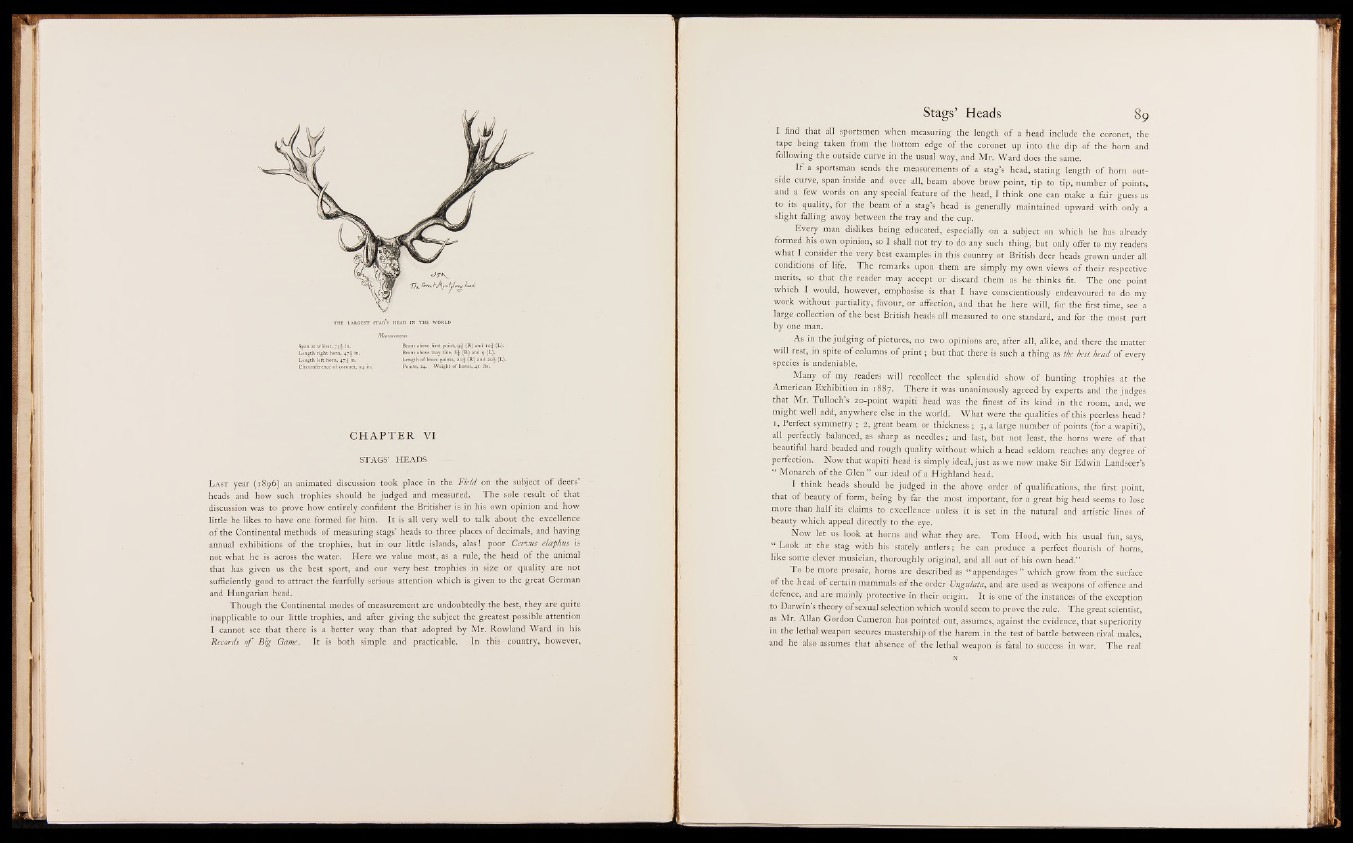
CH A P T E R VI
STAGS’ HEADS -
L ast year ( 1896) an animated discussion took place in the Field on the subject o f deers’
heads, and how such trophies should be judged and measured. T h e sole result o f that
discussion was to prove how entirely confident the Britisher is in his own opinion and how
little he likes to have one formed for him. It is all very well to talk about the excellence
o f the Continental methods o f measuring stags’ heads to three places o f decimals, and having
annual exhibitions o f the trophies, but in our little islands, alas! poor Cervus elaphus is
not what he is across the water. Here we value most, as a rule, the head of the animal
that has given us the best sport, and our very best trophies in size or quality are not
sufficiently good to attract the fearfully serious attention which is given to the great German
and Hungarian head.
Though the Continental modes o f measurement are undoubtedly the best, they are quite
inapplicable to our little trophies, and after giving the subject the greatest possible attention
I cannot see that there is a better way than that adopted by Mr. Rowland Ward in his
Records o f Big Game. It is both simple and practicable. In this country, however,
I find that all sportsmen when measuring the length o f a head include the coronet, the
tape being taken from the bottom edge o f the cordnet up into the dip of the horn and
following the outside curve in the usual way, and Mr. Ward does the same.
I f a sportsman sends the measurements o f a stag’s head, stating length o f horn outside
curve, span inside and over all, beam above brow point, tip to tip, number o f points,
and a few words on any special feature o f the head, I think one can make a fair guess as
*° *ts quality, for the beam o f a stag’s head is generally maintained upward with only a
slight falling away between the tray and the cup.
Every man dislikes being educated, especially on a subject on which he has already
formed his own opinion, so I shall not try to do any such thing, but only offer to my readers
what I consider the very best examples in this country ot British deer heads grown under all
conditions o f life. T h e remarks upon them are simply my own views o f their respective
merits, so that the reader may accept or discard them as he thinks fit. The one point
which I would, however, emphasise is that I have conscientiously endeavoured to do my
work without partiality, favour, or affection, and that he here will, for the first time, see a
large collection o f the best British heads all measured to one standard, and for the most part
by one man.
As in the judging o f pictures, no two opinions are, after all, alike, and there the matter
will rest, in spite o f columns o f p r in t ; but that there is such a thing as the best head o f every
species is undeniable.
Many o f my readers will recollect the Splendid show o f hunting trophies at the
American Exhibition in i88||. There it was unanimously agreed by experts and the judges
that Mr. Tulloch’s 20-point wapiti head was the finest o f its kind in the room, and, we
might well add, anywhere else in the world. What were the qualities o f this peerless head ?
1, Perfect symmetry ; 2, great beam or thickness ; 3, a large number o f points (for a wapiti),
all perfectly balanced, as sharp as needles; and last, but not least, the horns were o f that
beautiful hard beaded and rough quality without which a head seldom reaches any degree of
perfection. Now that wapiti head is simply ideal, just as we now make Sir Edwin Landseer’s
“ Monarch o f the GlenJJJmr ideal o f a Highland head.
I think heads should be judged in the above order o f qualifications, the first point,
that o f beauty o f form, being by far the most important, for a great big head seems to lose
more than half its claims to excellence unless it is set in the natural and artistic lines of
beauty which appeal directly to the eye.
| |bw let us look at horns and what they are. Tom Hood, with his usual fun, says,
‘ Look at the stag with his stately antlers; he can produce a perfect flourish o f horns,
like some clever musician, thoroughly original, and all out o f his own head.”
T o be more prosaic, horns are described as “ appendages” which grow from the surface
o f the head o f certain mammals o f the order TJngulata, and are used as weapons o f offence and
defence, and are mainly protective in their origin. It is one o f the instances o f the exception
t° Darwin s theory o f sexual selection which would seem to prove the rule. The great scientist,
as Mr. Allan Gordon Cameron has pointed out, assumes, against the evidence, that superiority
in the lethal weapon secures mastership o f the harem in the test o f battle between rival males,
and he also assumes that absence of the lethal weapon is fatal to success, in war. T h e real